ABSTRACT
Quantum perspective (1925-2021) in the 21st century is a departure from the modern science view of Rene Descartes (1596-1650) and Isaac Newton (1625-1727) in the 16th -18th century. Newtonian science and Cartesian logic captured the heart and mind of humanity’s pursuit for material wellbeing that led to colonialization and up till now an extensive globalization is taking place. The welfare of humanity described as common good was in the hands of democratic capitalists. The agricultural civilization, industrial civilization, global civilization and digital civilization have served human welfare at the expense of Mother Nature and the socio-economic imbalance continues to exist globally. The ecological civilization of China is a new model for environmental practice toward a socialist spiritual civilization. A quantum perspective on human welfare has been proposed by Martha Beck, Fahri Karakas and Margaret Wheatley that promotes a 21st century human welfare. This paper discusses the impact of quantum mechanics that altered mainstream management to multistream management; it presents an educational background on pedagogy, andragogy, and heutagogy; and it makes a distinction between digitization and digitalization in technology. Ir looks into the role of business management, educational and digital technology in creating a new world of human welfare.
Keywords Quantum perspective, Cartesian logic, Newtonian science, digitalization, digitilization, mainstream management, and multistream management.
INTRODUCTION
Marinoff (2007) in his book, The Middle Way, cited four ideographs that triggered four great civilizations. These are: Hellenic, Abrahamic, Sinic, and Vedic great ideas that flourished around the world. The onset of Cartesian philosophy triggered a rational approach to human thinking paradigm that was anchored on logic and reason. Rene Descartes was a leading figure in Rational Civilization. Newtonian physics that explained the laws of nature triggered a Scientific Civilization during the colonial period of exploration of natural resources. With abundant resources it propelled us to an Industrial Civilization. This was followed by a Global Civilization in the age of multinational corporations operating worldwide. The Digital Civilization made personal computers available to humanity, which connected us locally and globally. It made business even more prosperous and opened new ways to learn virtually. However, artificial intelligence, according to Harari, doing interface with humans creates a new relationship that makes us Homo Deus. The challenge is how to use AI for the welfare of humanity and not robotize humans. The Digital Civilization will be a contest between humans and machines.
II. OBJECTIVES
This study aims to: 1. Provide an understanding of the role of management, education and technology in human welfare from a quantum mechanics perspective. 2. Present the shift from Cartesian-Newtonian science to the New Science of quantum physics of Beck, Karakas and Wheatley. 3. Show the mainstream/old and multistream/new concepts in management. 4. Discuss educational learning approaches in the use of pedagogy, andragogy and heutagogy. 5. Differentiate digitalization and digitization in 21st century.
III. METHODOLOGY
This paper is a qualitative research (Marshall & Rossman, 2011); it is anchored on key documents that provide an understanding of the role of management, education and technology in promoting human welfare in the 21st century. It is heuristic (Moustakas, 1990) because it provides the researchers who are presenters and the webinar audience to discover and learn something for themselves in understanding the influence of quantum mechanics and other current development in the field of management, education and technology. It makes sense of the past experiences in these three disciplines and promotes new paradigms (Smith, 2015; Sela-Smith, 2002; Hudtohan, 2005; Gonzalez, Luz, & Tirol, 1984). The methodology is multi-valuate (Richardson, 2015) because it deals with various disciplines related to management, education and technology. This is an exploratory discourse (Stebbins, 2011) to study, examine, analyze and investigate the need for creativity and innovation in managing issues and challenges in these three sectors promote human welfare in the 21st century.
IV. DISCUSSION
MODERN PHYSICAL SCIENCE OF DESCARTES AND NEWTON
Touted as modern science, Rene Descartes (2006 trans.) philosophical affirm of “I think; therefore, I am” created a new awareness of the power of the human mind. Isaac Newton’s (1846) discovery of the physical laws of nature propelled the exploration of earthly resources during the colonial period of our history. The belief that man has dominion over the whole world was reinforced by the Catholic doctrine on man-centered perspective over God’s creation.
As early as 1925, quantum mechanics studied the scientific laws that describe the unusual behavior of photons, electrons and the other particles that make up. it’s the physics that explains how everything works: the best description we have of the nature of the particles that make up matter and the forces with which they interact. physics underlies how atoms work, and so why chemistry and biology work as they do. In quantum physics it avers that: The mind is the sole governing agency of the body.
Figure 1. Descartes, Newton and Quantum Mechanics
(https://www.facebook.com/Qmechanics/)
Knight (2018) echoes what Einstein said: “The field is the sole governing agency of the particle.” He continues to say that this revelation is huge if we apply it consciously to our life. it means the invisible field of energy, that is within us and all around us, is what creates and sustains matter. We can learn to tap into the field and therefore create our own reality. When each ONE of us is living in such a way, the world will become full of other ONES doing just the same, and the world will become a reflection of the ONEness that we all desire at a soul level. Your soul has come from the invisible field, and has created this ‘particle’ called a body, surely it is the least you can do to return the favor by acknowledging that creation and therefore helping your soul to fulfill its divine mission of realization, to know and be one love.” (Knight, 2016).
Quantum mechanics Is a science that deals with the behavior of matter and light on the atomic and subatomic scale. It attempts to describe the properties of molecules and atoms and their constituents—electrons, protons, neutrons, and other more esoteric particles such as quarks and gluons. These properties include the interactions of the particles with one another and with electromagnetic radiation (https://www.britannica.com/science/quantum-mechanics-physics).
PARADIGM SHIFT
There has been a shift from Newtonian physical science to a New Science of Quantum Physics. I am presenting Martha Beck’s Old World versus New World Perspectives, Fahri Karakas, Old and New Paradigms in organization development, and Margaret Wheatley’s Leadership and the New Science.
Martha Beck
. The spent old world of Beck is Newtonian worldview and the wild new world is the world of quantum mechanics. She contrasts the inner experience of individual, relationships, careers, industries and technology from these two perspectives
Table 1. Old World versus New World Perspectives
Fahri Karakas
Fahri Karakas presents old and new paradigms in organization development (OD). The influence of quantum physics is summarized as follows: traditional organization development models are giving way to new intervention methods and models in an age of uncertainty, complexity, globalization, and accelerating change. Karakas suggests new roles for OD professionals in the 21st century as social artist, ethical pioneer, spiritual visionary, creative catalyst, cultural innovator, holistic thinker, and community builder. (Karakas, 2006). Table 2 shows the old and new paradigms in Organization Development, covering: 1. Old vs. New Science, 2. Profit vs. Multiple Goals, 3, Uniformity vs. Diversity, 4. Command/control vs. Flexibility/empowerment,5. Certainty vs. Uncertainty, 6. Partial vs. Impartial View, 7. Old vs. New Metaphors.
Table 2. Changing Paradigms of Organization Development
Margaret Wheatley
Margaret Wheatley presents a new leadership and the new science of quantum physics. She describes how new developments in the sciences show us how to design a new, more effective organizational structure. The new structure is more responsive to human needs and to our rapidly changing times. Based on this understanding, you need to make our organization more flexible and adaptable
Wheatley explains the need to get rid of our old outdated mechanistic models and adapt our organizations to prosper in the future. Our accepted analytical world view, based on using logical analysis and relying numbers to chart progress, should be replaced. She makes a compelling case and urges organizations to become more effective by becoming more human and natural. getAbstract.com recommends this pivotal book to leaders at all levels. Figure 3 contrasts: 1. Newtonian vs. New Science, 2. Organization as an open vs. closed system, 3. Identity in organizations, 4. Information, 5. Relationship.
Table 3. Newtonian and New Science
| Newtonian Machine imagery. Everything in parts. | New Science Holistic. |
| Materialistic. Use of physical senses. | Relationships are key. |
| Direct mechanistic forces. | Fields. |
| Deterministic. | Probabilities. |
| Never ending search for better methods of objectively measuring and perceiving the world. | Understanding that there is no model for organizational change. |
Table 4. Organization as a System
| Newtonian Interacts with its environment. | New Science Isolated from its environment. |
| Receiving new inputs constantly and responding (learning) to cope. | Exists independent of environment. |
| Interdependent. | Self-sufficient. |
| Adaptive and flexible. | Does not adapt external influences. |
| Import energy/export entropy. | Components are unchanging. |
| Autopoiesis. | Entropy. |
| Disequilibrium. | Equilibrium. |
Life organizes around identity. In organizations, if people are free to make their own decisions, guided by a clear organizational identity for them to reference, the whole system develops greater coherence and strength. The organization is less controlling, but more orderly.
Table 5. Identity in organizations
| Newtonian | New Science |
| No individual decision making | Self-reference |
| Organizational structure established by authority | Self-organizing |
| Controlled | Freedom throughout |
| People are cogs | People are quantum |
| Rigid structure | Flexible structure |
Information is an essential nourishing element for all systems. It is a fundamental yet invisible player in a constantly evolving, dynamic universe. All life uses information to organize itself into form.
Table 6. Information
| Newtonian Tangible. | New Science Intangible. |
| Controllable, stable, and obedient. | Dynamic. Can generate itself. |
| Must be controlled for stability. | Free flow necessary for new order. |
| Limited access and generation. | Must be continually generated. |
| Power. | Nourishment. |
We give up predictability and open up to potentials by understanding relationships. What potential becomes reality, depends on the relationships created between multiple elements: People, events, and the moment. None of us exists independent of our relations with others. Neither the system nor the individual is the more important influence of behavior. Each organism in a system maintains a clear sense of its individual identity within a larger network of relationships that help shape its identity.
What potential becomes reality, depends on the relationships created between multiple elements: People, events and the moment. None of us exists independent of our relations with others. Neither the system nor the individual is the more important influence of behavior. Each organism in a system maintains a clear sense of its individual identity within a larger network of relationships that help shape it’s identity. The Web of Relationships in Organizations power, which is the capacity generated by organizational relationships. In developing Relationships, quality not quantity is key. We have to look everywhere in order to assessing our organization’s capacity for healthy relationships.
Table 7. Relationships
| Individualism. | Principle of Complementarity. |
| Competition. | Uncertainty Principle. |
| Critical Mass. | Critical Connections. |
| Objectivity. | Enactment. |
Conclusion: New Leadership Role
Leaders should: 1. Help develop a clear identity that lights the dark in moments of confusion.
2. Support employees as they learn to incorporate values into their organizational lives.
3. Understand we are controlled by concepts that invite our participation, not policies and procedures that curtail our contribution.
4. Create space where people, ideas, and information circulate freely.
MAINSTREAM vs. MULTISTREAM MANAGEMENT
The implication of quantum physics in management today on management. According to Kaplan (2014) “Management is directing and controlling a group of people or an organization to reach a goal. Management often means the deployment and manipulation of human resources, financial resources, technological resources, and natural resources.” (Kaplan, 2014). Dyck and Neubert (2012) defines management science as “applied mathematics, statistics, and other quantitative techniques to management planning, decision making, and problem solving.” (p. 45).
An organization is a goal-directed, deliberately structured group of people working together to achieve results. Henri Fayol’s (1949) four functions of management are: Planning, (Organizing, Leading and Controlling. Henry Mintzberg (1987) conceptualized Managerial Roles and Subrules as: Interpersonal roles (leader, liaison, figurehead), Decisional roles (resource allocator, negotiator, entrepreneur, crisis handler) and Informational roles (monitor, disseminator, spokesperson).
There are two approaches to defining effective management (Max Weber, 1947; in Gerth & Mills,1958). But it was Dyck and Neubert (2012) that coined mainstream and multistream management. Mainstream management emphasis is on materialism and individualism and its primary goals includes maximizing productivity, profitability, and competitiveness. However, Multistream management emphasis is on multiple forms of well-being and multiple stakeholders. There are nine elements of well-being. (Dyck & Neubert, 2012).
1. Aesthetic: beauty, art, poetry.
2. Ecological: natural environment, minimal pollution.
3. Emotional: satisfaction, positive feelings, hope, joy.
4. Individual: personal convenience, one’s own interests.
5. Intellectual: ideas, clear rationale, theory, concepts.
6. Material: Finances, productivity, tangible goods, efficiency.
7. Physical: health, safety, security.
8. Social: community-mindedness, justice, helping others.
9. Spiritual: meaning, interconnectedness, transcendent,
Mainstream and Multistream managers represent two prototypes or ideal types on opposite extremes of a continuum (Dyck & Neubert, 2012).
Table 8. Mainstream/Old vs. Multistream/New Management

- Two approaches to planning: a) Mainstream: measurable goals, bottom-line monetary focus, top-down linear analysis; uses SMART 1: Specific, Measurable, Achievable, Results-based, Time-specific; and b) Multistream: practical wisdom, participation, goals other than monetary. Uses SMART 2: Significant, Meaningful, Agreed upon, Relevant, Timely.
Table 9. Mainstream vs. Multistream Planning
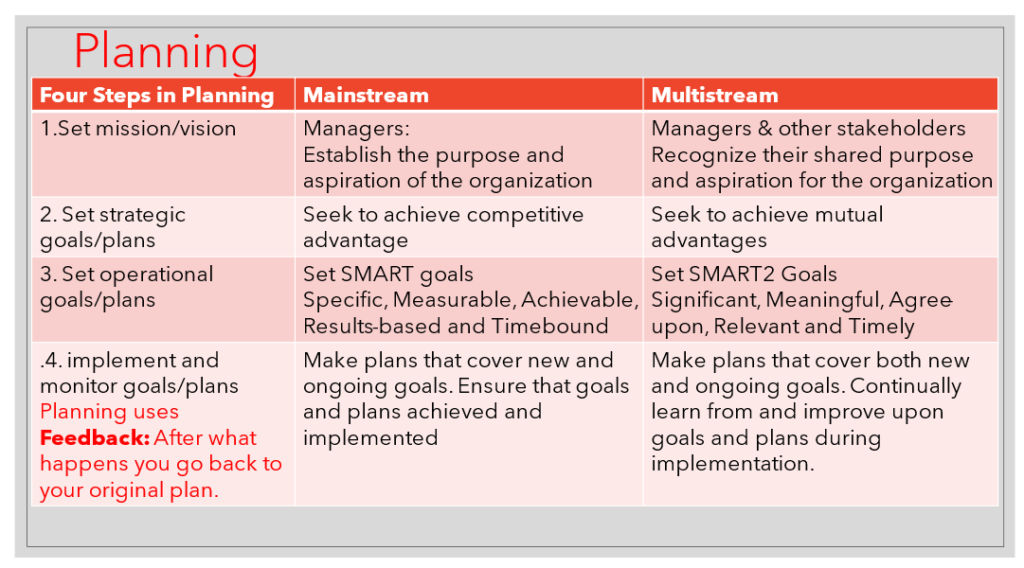
2. Two approaches to organizing: a) Mainstream: centralization, standardization, specialization and b) Multistream: courage, experimentation (1) Courage – implementing initiatives that have potential to improve overall happiness even if it might threaten one’s own status.
Table 10. Mainstream vs. Multistream Organizing
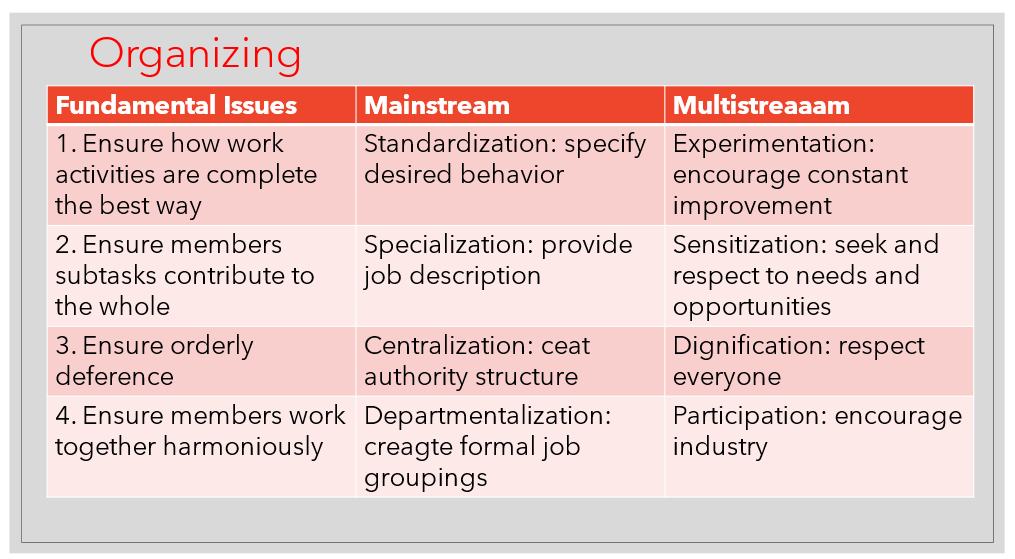
3.Two approaches to leading: a) Mainstream: instrumental motivation, extrinsic rewards, output-oriented (1) Instrumental skills – Getting people to act in ways that fulfill our own needs b) Multistream: relational self-control, dignity, facilitate intrinsic motivation (1) Relationship skills – Used to create and deepen relationships because relationships are viewed as ends rather than as means to achieve one’s personal objectives.
Table 11. Mainstream vs. Multistream Leading
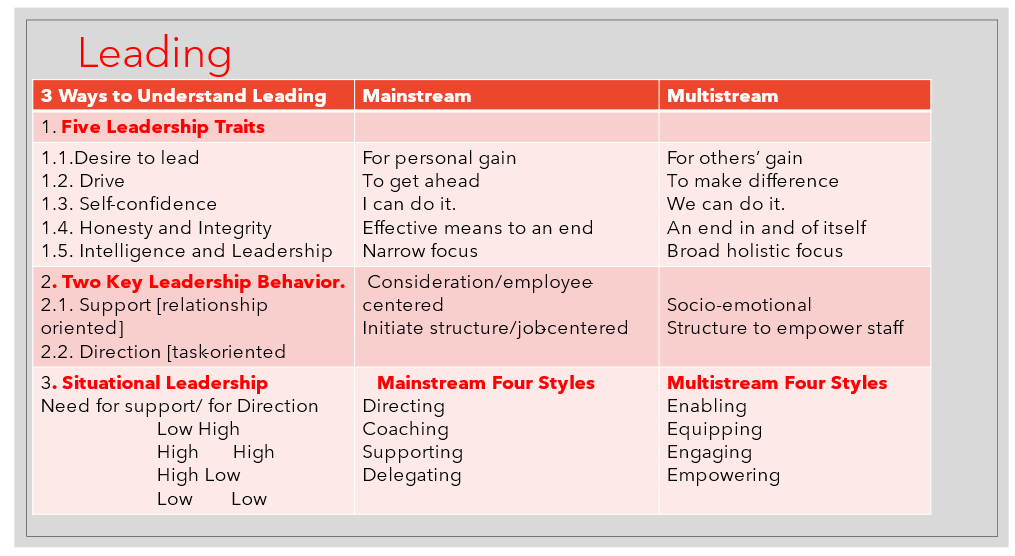
- Two approaches to controlling: a) Mainstream: vigilance, monitoring, ensuring that members do what they are supposed to be doing: (1) Value chain is sequencing of activities needed to convert organizational inputs into outputs. (2) Information systems helps identify, collect, organize, and disseminate information. (3) Bureaucratic control is emphasis on rules, regulations, policies, and standard operating procedures to control organizational members and b) Multistream: (1) controlling via fairness and being sensitive to sub-optimal conditions. (2) ensuring actions are consistent the organization’s values and standard.
Table 12. Mainstream v. Multistream Controlling
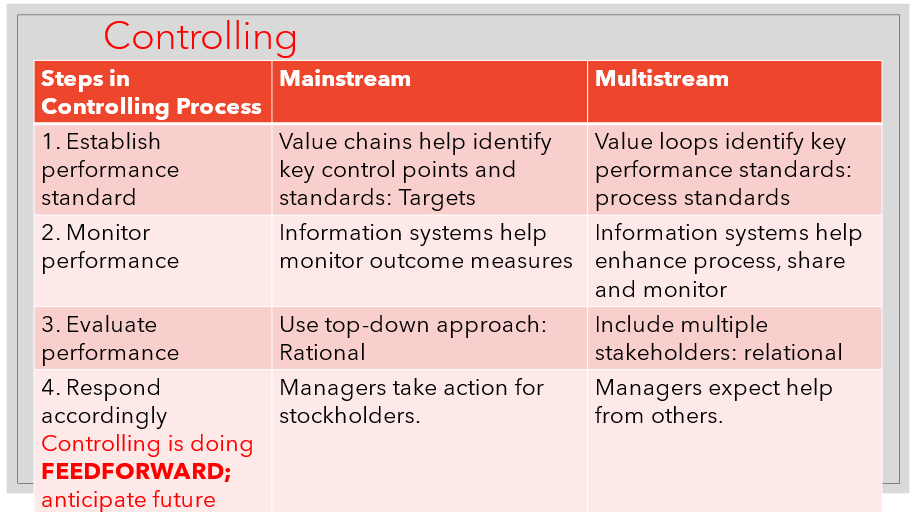
Mainstream Management is based on Newtonian physical science; the discovery of the: Laws of Nature made mankind focus on the resources of the earth. Literally, the biblical command to “Have dominion over the whole world” was taken seriously by Great Britain’s conquest where the sun never sets at the British Empire during the colonial period. Spain and Portugal divided the world and it was validated by the Pope of the Roman Catholics. Christopher Columbus and Ferdinand Magellan explored various parts of the globe. Statistics and mathematical formulae became scientific models in explaining natural phenomena. Cartesian logic became the popular syllogism.
Multistream Management is better understood in terms of metaphysics. Quantum Physics. the study of smallest particle of matter; it espouses the power of human consciousness, such that “the mind is [considered] the soul governing agency of the body”. Further appreciation of the mind-body relationship is the assertion of that the new atom is 99.999 percent energy and only .009 percent matter. Translated into our human existence, we are therefore energy and very insignificant matter. Einstein’s Energy equals Mass time Speed of Light squared affirms our nature as spirit in relation to our body, which has energy. Teilhard de Chardin (1993) and Covey (2000) affirms that we are spiritual beings with human activities and not the other way around.
The observer-reality relationship in quantum physics illuminates objectivity because quantum physics “tells us that nothing that is observed is unaffected by the observer. That statement, from science, holds an enormous powerful insight. It means that everyone sees a different truth because everyone is creating what they see.” (Walsh, 2016). Bluestone (1997) says, “Western and Chinese alchemist had one thing in common…the smallest object of material reality was a reflection of a larger cosmic whole. Monk Basil Valenti the human body was a microcosm of the universe. In the Chinese Tao, everything on earth was a reflection of its divine form.” (p. 62).
In the 21st century Harari (2018) asserts that he who owns data owns the future. Taleb (2012) avers that we need to be antifragile amidst the challenges of this century. Is Technology the New King, going hand in hand with the Queen of Social Sciences? Dyck and Neubert (2012) challenges the traditional business paradigm as they consider mainstream [old] as a total concentration on profit but with multistream management the [new] concern of business well-being. Harari (2016) in Homo Deus asserts that our species as humans is has been evolving from the lower life forms to being a Homo Sapiens, which believes is headed to be Homo Deus, a technologically sophisticate human form. In 21 Lessons for the 21st Century, again, he predicted and it is happening now that he who hold data, big data holds the future.
EDUCATION IN THE 21ST CENTURY
Pedagogy.
The original description of learning methodology is pedagogy, which is the “art, science, or profession of teaching; especially: education.” (Merriam-Webster). This definition covers many aspects of teaching which include teaching styles, feedback, and assessment. Current views cites pedagogy to literally mean “leading children.”
Malcolm Knowles (1984) theorized that methods used to teach children are often not the most effective means of teaching adults. Pedagogy is a child-focused teaching approach, whereas andragogy an adult-focused teaching approach; or, formally, pedagogy is the art and science of helping kids learn, whereas andragogy is the art and science of helping adults learn. Malcolm Knowles (1984) says that andragogy is based on a self-directed, independent learning method for adults. This theory asserts that learning programs must support the notion that adults are self-driven and take responsibility for decisions.
Andragogy
Andragogy is a term coined to refer to the art/science of teaching adults. Knowles’ (1984) theory of andragogy is an attempt to develop a theory specifically for adult learning. Knowles emphasizes that adults are self-directed and expect to take responsibility for decisions. Adult learning programs must accommodate this fundamental aspect. Thus, andragogy is an approach in participatory learning based on the premise that adult students are propelled to learn on real life situation based as they can bring they own experiences and knowledge into the classroom and they can immediately practice to their lives and careers.
Mezirow’s (1991) transformative learning is defined as “an orientation which holds that the way learners interpret and reinterpret their sense experience is central to making meaning and hence learning.” Put in simple terms, transformative learning is the idea that learners who are getting new information are also evaluating their past ideas and understanding, and are shifting their very worldview as they obtain new information and through critical reflection. It goes beyond simply acquiring knowledge, and dives into the way that learners find meaning in their lives and understanding. This kind of learning experience involves a fundamental change in our perceptions—learners start to question all the things they knew or thought before and examine things from new perspectives in order to make room for new insights and information. Many learners and experts agree that this kind of learning leads to true freedom of thought and understanding.
Mezirow (1991) says that transformative learning has two basic focuses—instrumental learning and communicative learning. Instrumental learning focuses on task-oriented problem solving, and evaluation of cause-and-effect relationships. Communicative learning focuses on how people communicate their feelings, needs, and desires. Both of these elements are important in transformative learning—students need to be able to focus on different types of their understanding and view new perspectives that are both logical and emotional in order to challenge their previous understanding.
Meaning schemes or meaning structures are another important element of the transformative theory and transformational learning according to Mezirow. Perspectives and meaning schemes two major elements of meaning structures, and are our predispositions and assumptions, which set the state for our expectations. A meaning structure is basically the concepts, beliefs, judgments, and feelings that shape an interpretation of information. Students are able to understand their meaning structure through self-reflection, self-directed learning, and critical theory. They are able to critique their assumptions to understand if what they understood as a child still holds true now that they are an adult. We are thereby able to understand ourselves, and our learning better. The understanding of our past perspective and the ability to look at new structures and perspectives are key to the transformative learning theory.
1. An understanding of the differences in assumptions about learners and the skills required
for learning under teacher-directed learning and self-directed learning, and the ability to
explain these differences to others.
2. A concept of myself as being a non-dependent and a self-directing person.
3. The ability to relate to peers collaboratively, to see them as resources for diagnosing needs,
planning my learning, and learning; and to give help to them and receive help from them.
4. The ability to diagnose my own learning needs realistically, with help from teachers and
peers.
5. The ability to translate learning needs into learning objectives in a form that makes it
possible for their accomplishment to be assessed.
6. The ability to relate to teachers as facilitators, helpers, or consultants, and to take the
initiative in making use of their resources.
7. The ability to identify human and material resources appropriate to different kinds of
Learning objectives.
8. The ability to select effective strategies for making use of learning resources and to perform
these strategies skillfully and with initiative
9. The ability to collect and validate evidence of the accomplishment of various kinds of
learning objectives. (Henschke, 2009).
The role of the instructor and the participation of the learning is shown in Figure 1. The continuum shows that in pedagogy the learner has less control in method and learning content; heutagogy allows the learner to be self-determined. In terms of the role of the instructor, in pedagogy, there is more instructor control and course structuring; in heutagogy there is less instructor control and course structuring.
The idea is that the learner drives the learning completely, independently, and does not follow a linear route. The learner seeks self-actualization and goes through a process of personal values development (Maslow, 1962; McLeod, 2020; Hall Kalven, Rosen, & Taylor, c1991); The teacher is simply a guide and facilitator (Sing, n.d.) inside and outside the classroom, face-to-face or virtual learning.
.
Figure 1. Learner’s freedom in Pedagogy, Andragogy and Heutagogy
www.schoology.com/blog/heutagogy-explained-self-determined-learning-education
Heutagogy
The term heutagogy was first coined by Stewart Hase and Chris Kenyon in 2000 as an extension to andragogy and means self-determined learning. Its foundations are constructivism and humanism, along with capability, open-systems thinking and complexity theory.
Heutagogy, a form of self-determined learning with practices and principles rooted in andragogy. In a heutagogical approach to teaching and learning, learners are highly autonomous and self-determined and emphasis is placed on development of learner capacity and capability with the goal of producing learners who are well-prepared for the complexities of 31st century workplace. The approach is most appropriate in dealing with emerging technologies in virtual learning through distance education and for guiding distance education practice and the ways in which distance educators develop and deliver instruction using newer technologies such as social media and applications, like CANVAS and Microsoft Team.
Blaschke (2019) avers that educators need to equip students for 21st century workforce in a world in which lifelong learning; one approach is to develop a self-determined, autonomous learners capable of acquiring and building upon their knowledge through online personal learning environments (PLEs). A comparative description on the elements of pedagogy, andragogy and heutagogy is shown in Table 13. It differentiates learning aspects in terms of 1. Dependence, 2. Teaching resources, 3. Learning reasons, 4. Learning focus, 5. Motivation, and 6. Teaching role.
Heutagogy in Figure 2 shows the four dimensions of a learning designing in a heutagogical approach: 1. Learning agency, 2. Capability/self-efficacy, 3. Reflection/metacognition and 4. Non-linear design.
Figure 2. Learning Dimensions of Heutagogy
https://link.springer.com/chapter/10.1007/978-981-13-7740-2_9
A comparative description on the elements of pedagogy, andragogy and heutagogy is shown in Table 13. It differentiates learning aspects in terms of 1. Dependence, 2. Teaching resources, 3. Learning reasons, 4. Learning focus, 5. Motivation, and 6. Teaching role. Heutagogy is a philosophical approach that aims to help learners self-develop as problem-solvers, trouble-shooters and action-takers making continuous improvement: those who can work developmentally in learning organizations.
Table 13. Pedagogy, Andragogy and Heutagogy
www.samyoung.co.nz/2018/03/heutagogy-art-of-self-directed-learning.html
The 21st century dominated by artificial intelligence (AI) that has invaded our educational institutions, heutagogical approach plays a critical mode in the delivery of learning inside and outside the classroom. The renewed interest in heutagogy is partially due to the existence of Web 2.0 being promoted by the technology. With its learner-centered design, Web 2.0 technology offers an environment that supports a heutagogical approach, most importantly by supporting development of learner-generated content and learner self-directedness in information discovery and in defining the learning path. (Blaschke, n.d.)
DIGITAL TECHNOLOGY
Pande and Vian (2009) aver that the citizen of the future will be “a native of the network and that changes everything. It tempers border-based boundaries. It refocuses political notion on issues that are both more local and more global at he same time. It links expressiveness to empowerment and turns the smart consumer o the early internet era into activist citizen of the coming decades. The network superstructs citizenship.” Harari (2016; 2018) affirms the role of technology in all aspects of the life of a 21st century human who has become a Homo Deus, interacting with artificial intelligence in a widely networked relationship.
Human Welfare, Digitilization, Digitalization and Digital Transformation
Human welfare encompasses many aspects of an individual’s wellbeing, including their labor rights, working conditions, equitable treatment and access to resources and opportunities, regardless of their sex or gender. Welfare ub economics is the study of how the allocation of resources and goods affects social welfare. … In practical terms, welfare economists seek to provide tools to guide public policy to achieve beneficial social and economic outcomes for all of society. The classical definition of human welfare in Aristotelian philosophy is for each one to fine happiness. He cites the pursuit of what is true, good and beautiful as ultimate objects for human to be happy. In a democratic setting, the idea of common good is stressed over and above personal good. The United Nations has made a declaration on Human Rights to secure the happiness of every citizen. However, with the rise of digital technology human welfare is drastically challenged as human freedom and personal rights are under attack.
Digitilization refers to information while digitalization refers to the process. Digitalization refers to enabling or improving processes by leveraging digital technologies and digitized data. Digital Transformation is really business transformation enabled by digitalization. (Cruz, 2021).
Digitization is the process of converting information from a physical format to digital one. It means converting something non-digital into a digital representation to be used by computer systems and automate processes or workflows. Digitization enables to create business value, which needs data. It helps to lay the foundation for business use cases that leverage the data.
Digitalization is the process of leveraging digitization to improve business processes. Digitalization means making digitized information work for you. This term refers to the use of digital technologies and data to create revenue, improve business, and create a digital culture where digital information is at the core. It converts processes to be more efficient, productive, and profitable.
Digital technology are tools that include all automatic systems, technological devisees that generate, process or store information.it has practically replaced what used to be known as analog technology. Examples are websites, online buying and selling; smartphones, block chain, cryptocurrency, clout computing, voice interfaces or chat boxes; video streaming, eBooks, blogs, social media, 3D printing; ATM machines; digital cameras and drones. (Cruz, 2021)
Digital transformation is the transformation of business activities, processes, products, and models to fully leverage the opportunities of digital technologies. The main goal is to improve efficiency, manage risk or discover new monetization opportunities. Digital transformation is doing things in a new (digital) way.
The Future
Harari (2016) in Homo Deus asserts that our species as humans is has been evolving from the lower life forms to being a Homo Sapiens, which believes is headed to be Homo Deus, a technologically sophisticate human form. The power of digital technology is summarized in a saying that “He who hold big data, hold the future. Access to data has come the key to economic and political power. It has become the key to commercial success. The abuse of data privacy by many strong companies that have monopolized data technologies has been a source of worry for most people. That is the reason we are seeing the increase of governments imposing data privacy laws.
In 21 Lessons for the 21st Century, again, he predicted and it is happening now that he who hold data, big data holds the future. He continues to say, “Humankind is losing faith in the liberal story that dominated global politics in recent decades, exactly where the merger of biotech and infotech confronts us with the biggest challenges humankind has ever encountered.” (Harari, 2018).
He concludes on the power and dominance of technology through artificial intelligence (AI), “If we manage to combine a universal econo0mic safety net with strong communities and meaningful pursuits, losing our jobs to the algorithms might actually turn out to be a blessing. Losing control over our lives, however, is a much scarier scenario. Notwithstanding the danger of mass unemployment, what we should worry about even more is the shift I authority from humans to algorithms, which might destroy any remaining faith in the liberal story and open the way to the rise of digital dictatorship.
CONCLUSIONS
1. Cartesian philosophy and Newtonian physical science influenced business management to focus on material gain and bottom-line profitability of mainstream/old management. At times, this was at the expense of human welfare of the laborers and the community.
2. Three quantum gurus were presented to show the shift in leadership and organizational development from Cartersian-Newtonian science to a quantum perspective in personal development and organizational development.
3. Quantum mechanics influenced business management to focus on our higher consciousness, addressing wellbeing of stakeholders. Profitability is only one of the 9 goals of multistream/new management.
4. In education, attention should be given to pedagogy as child learning method, andragogy as adult-learning method and heutagogy as self-efficacious method. Teachers must adjust their learning methods based on the age and learning maturity of the students. No more one method fits all learners.
5. The Age of Digitalization has posed tremendous benefits for humanity. The speed and the scope of communication technology has brought humanity to state of virtual reality that allows relationships to prosper in a distance.
6. Business has the greatest advantage in promoting its economic interest through digital technology that allow innovation products that are available globally. But business has also taken advantage of technology to further capture humanity and expand its economic interests.
7. The rise of AI continues to promote benefits to humanity in biotechnology and infotechnology. However, from the point of view of ultimate control and dominance there is a question on whether technology will enslave humanity under a modified form of governance.
8. The challenge then is: Will humanity surrender its freedom to AI or will AI in the hand of a few control humanity.
REFERENCES
Beck, M.N. (2012). Finding Your Way in a Wild New World: Reclaim Your True Nature to Create the Life You Want. New York: Free Press.
Blaschke, L.M. (n.d.) Heutagogy and Lifelong Learning: A Review of Heutagogical Practice and Self-Determined Learning. https://files.eric.ed.gov/fulltext/EJ979639.pdf
Blaschke, L.M. (2019). The Pedagogy–Andragogy–Heutagogy Continuum and Technology-Supported Personal Learning Environments. https://link.springer.com/chapter/10.1007/978-981-13-7740-2_9.
Bluestone, S. (1997). Signs of the times. New York: Berkley Publishing Group.
Cruz, E.S. (Nov. 7, 2021). A digital world, Breakthrough. The Philippine Daily Inquirer.
de Chardin. P.T. in The Joy of Kindness (1993), by Robert J. Furey, p. 138; attributed to G. I.
Gurdjieff in Beyond Prophecies and Predictions: Everyone’s Guide to The Coming Changes (1993) by Moira Timms, p. 62; neither cite a source; popularized by Wayne Dyer, who often quotes it in his presentations, crediting it to Chardin, as does Stephen Covey in Living the 7 Habits : Stories of Courage and Inspiration (2000), p. 47. Such statements could be considered paraphrases of Hegel’s dictum that matter is spirit fallen into a state of self-otherness.
Descartes, R. (2008). Meditations on first philosophy. Translated by Michael Moriarty, Oxford University Press.
Dyck, B. & Neubert, M.J. (2012). Management. Singapore: Cengage Learning.
Fayol, H. (1949). General and industrial management. London, Pitman.
Gonzalez, F.S.C., Luz, J. M., & Tirol, M.H. (1984). De La Salle mission statement:
Retrospect and prospect. Quezon City: Vera Reyes, Inc., 46, 19-24, 14-16, 4.
Hall, B., Kalven, J., Rosen, L.S., & Taylor, B. (c1991). Values Development: Diagnostic Sourcebook. WI: International Values Institute of Mariam College.
Hapon, M. (2021), What Is the Difference Between Digitization, Digitalization and Digital
Transformation. (https://www.netguru.com/blog/digitization-and-digitalization)
Harari, Y. N. (2016). Homo deus: A brief history of tomorrow. London: Vintage.
__________.(2018). 21 lessons for the 21st century. London: Jonathan Cape.
Hase, S. & Kenyon, 2000). From andragogy to heutagogy. https://www.researchgate.net/publication/301339522_From_andragogy_to_heutagogy
Henschke, J. A. (2009). A Perspective on the History and Philosophy of Andragogy: An International
Sketch. IACE Hall of Fame Repository.
https://trace.tennessee.edu/cgi/viewcontent.cgi?referer=https://www.google.com/&httpsredir=1&article=1433&context=utk_IACE-browseall
Hudtohan, E. T. (2005). 50 years of De La Salle catechetical program: Retrospect and prospect. Retrieved
from https://animorepository.dlsu.edu.ph/etd_doctoral/104
Karakas, F. (2009). New paradigms in organization development: Positivity, spirituality, and complexity.
Organization Development Journal, 27(1), https://psycnet.apa.org/record/2010-06172-001
Kaplan, A. (2014). European Management and European Business Schools: Insights from the History of
Business Schools, European Management Journal.
Knowles, M. S. (1984). Andragogy in action. San Francisco: Jossey-Bass.
McLeod, S. (2020). Maslow’s Hierarchy of Needs. https://www.simplypsychology.org/maslow.html
Marinoff, (2007). The middle way: Finding happiness in a world of extremes. NY: Sterling Publishing Co.,
Inc.
Marshall, C. & Rossman, G.B. (2011). Designing qualitative research. London: Sage Publications.
Maslow, A. H. (1962). Toward a psychology of being. Princeton: D. Van Nostrand Company.
Max Weber, M. (1947). The theory of Social and economic organization. New York: Free Press.
Mintzberg, H. (1989). Mintzberg on management: Inside our strange world of organizations. New York:
Harper and Row.
Mezirow, J. (1991). Transformative dimensions of adult learning. San Francisco: Jossey-Bass.
Moustakas, C. & Douglass, B. (1985). Heuristic inquiry: The internal search to know. Journal of
Humanistic Psychology, 25(3).
Newton, I (1642-1727). Principia: Thhe mathematical principles of natural philosophy / (New-York : Published by Daniel Adee, [c1846] https://www.researchgate.net/publication/301339522_From_andragogy_to_heutagogy
Pande, M. & Vian, K. (2009). Civil Society: Networked Citizens. Ten-Year Forecast Perspective, Institute of the Future. www.iftf.org.
Richardson, M.H. (2015). The quantum God: An investigation of the image of God from Quantum
Science. A masteral thesis. St. Mary’s University. Halifax. Nova Scotia
Sela-Smith, S. (July 2002). Heuristic Research: A Review and Critique of Moustakas’s Method
Journal of Humanistic Psychology 42(3):53-88.
Singh, S. (n.d.). Teaching & Research: Role of Teacher as Facilitator in Classroom.
Smith, J. (2015). Business research methodology. New York: Arcler Press LLC.
Stebbins, R.A. (2011). What Is Exploration? In: Exploratory Research in the Social Sciences
London: SAGE Publications, Inc. City: Thousand Oaks
Taleb, N. N. (2012). Antifragile: Things that gain from disorder. New York: Random House
Tony Knight @ freeAgent42, (2018). https://medium.com/@tonyknight_92437/the-field-is-the-sole-
governing-agency-of-the-particle-einstein-1f770090a926
Walsh, R. (2007). The world of shamanism: New views of an ancient tradition. Woodbury, Minnesota:
Llewellyn Publication, p.59.
Weber, M. (1947). Theory of Social and Economic Organization. New York : London :Free Press
Weber, M., In Gerth, H., & In Mills, C. W. (1958). From Max Weber: Essays in sociology. New York:
Oxford University Press
Wheatley, M.J. (2006). Leadership and the new science: discovering order in a chaotic world. San
Francisco: Berrett-Koehler Publishers.
__________. (2007). Finding our way: Leadership for an uncertain time. San Francisco, CA: Berrett-
Koehler Publishing.
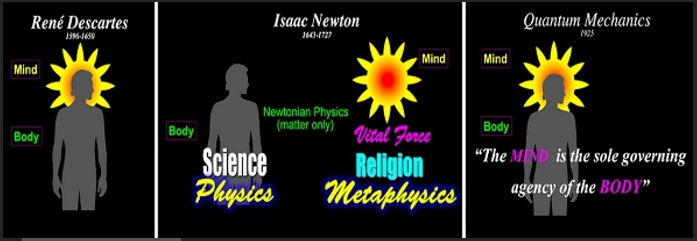
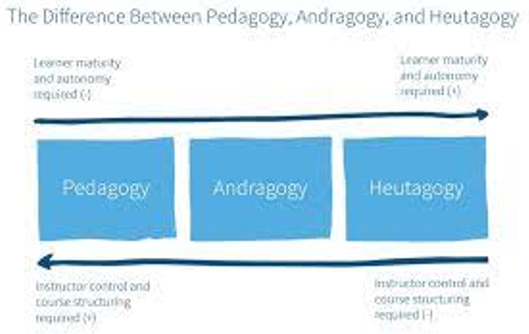
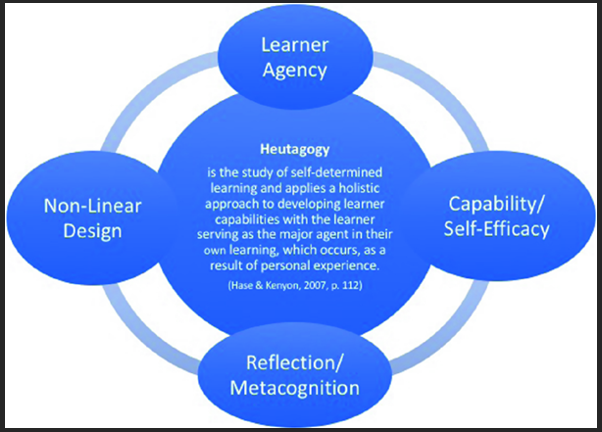
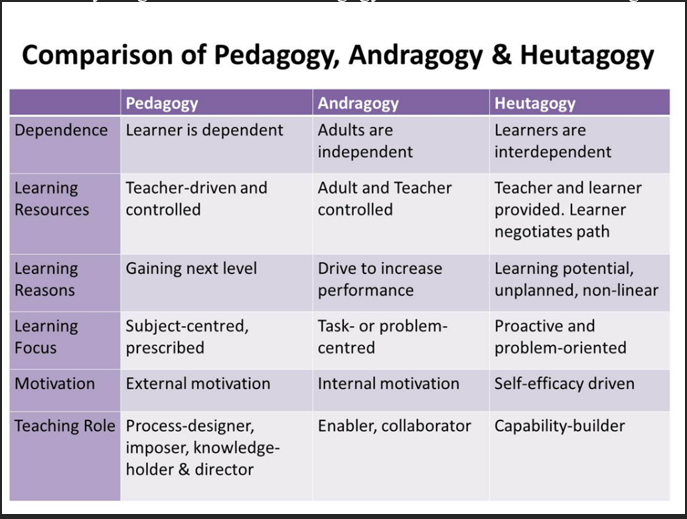




Leave a Reply
You must be logged in to post a comment.